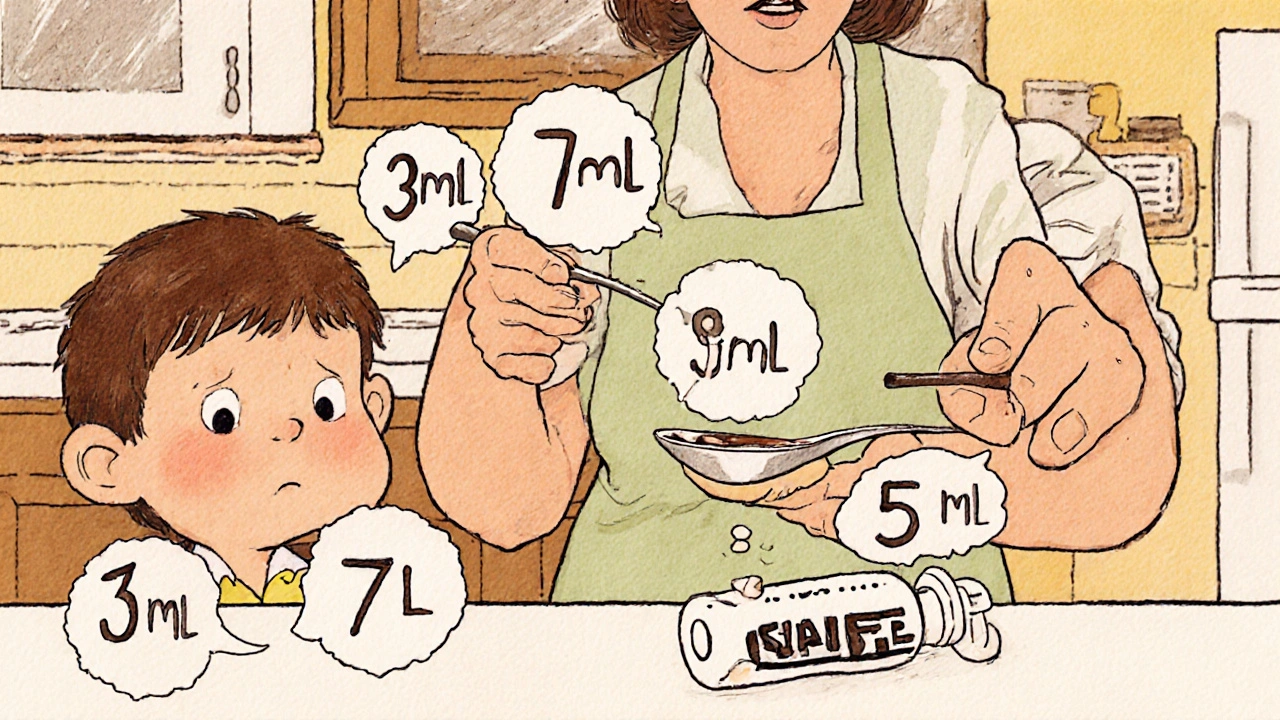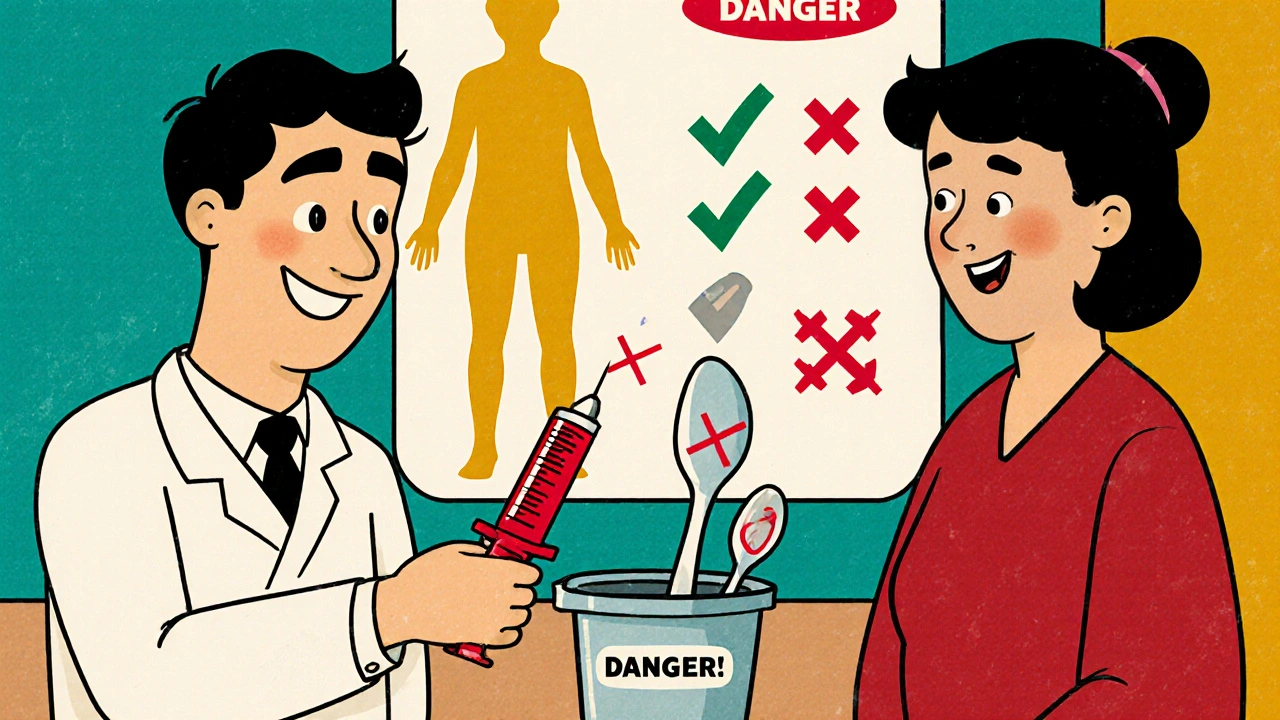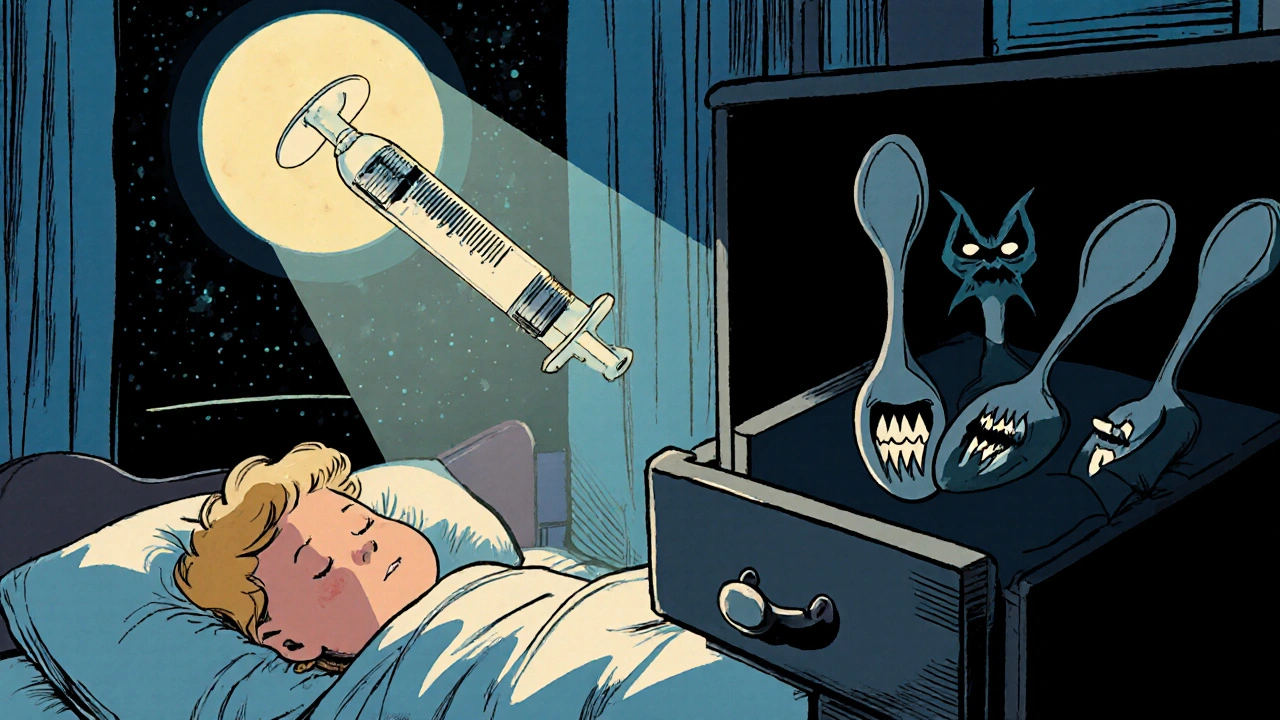Never Use Household Spoons for Children’s Medicine Dosing: Why Accuracy Saves Lives
 Nov, 10 2025
Nov, 10 2025
Every year, more than 10,000 calls are made to poison control centers in the U.S. alone - not because kids ate something toxic, but because someone gave them the wrong amount of medicine. And the most common mistake? Using a household spoon to measure liquid medication.
It seems harmless. You’re in a hurry. The medicine bottle says "5 mL" - but you don’t have a syringe handy. So you grab the teaspoon from the drawer. It looks right. It’s the one you use for sugar. But here’s the problem: that spoon isn’t accurate. Not even close.
Why Household Spoons Are Dangerous for Kids’ Medicine
A real medical teaspoon holds exactly 5 milliliters (mL). A tablespoon holds 15 mL. Simple, right? But a kitchen teaspoon? It can hold anywhere from 3 mL to 7 mL. That’s a 40% difference. One spoon might give your child barely enough medicine. Another might give them more than double the dose.
That’s not just a small mistake. It’s a risk. Children’s bodies are smaller. Their organs are still developing. A dose that’s safe for an adult could be toxic for a 2-year-old. Overdosing can cause drowsiness, breathing problems, seizures, or even organ damage. Underdosing? That means the infection isn’t treated. The fever stays. The cough lingers. The illness gets worse.
Research from the Pediatrics journal found that nearly 40% of parents made mistakes when using household spoons. Over 41% didn’t measure the dose correctly - even when they thought they did. And the worst part? Most parents had no idea they were doing it wrong.
The Real Difference Between mL and Teaspoons
Labels that say "give 1 tsp" are dangerous. Why? Because when parents see "teaspoon," they think of the one in their kitchen. A 2016 study showed that when labels used "tsp" or "teaspoon," one-third of parents said they’d use a kitchen spoon. But when the label said "5 mL," less than 10% did.
It’s not about literacy. It’s about habit. People have been using spoons to measure medicine for decades. But that habit kills. The American Academy of Pediatrics has been warning about this since 1978. Yet, 75% of American households still use kitchen spoons for medicine.
Milliliters (mL) aren’t just a scientific unit - they’re a safety tool. They’re precise. They’re universal. There’s no confusion. A 5 mL syringe is always 5 mL, no matter where you are, what brand it is, or how old your spoon is.
What You Should Use Instead
You don’t need fancy gear. You just need the right tools - and they come with the medicine.
- Oral syringes - the most accurate tool for doses under 5 mL. They measure down to 0.1 mL. Perfect for babies and small children. Just pull the plunger to the right line, gently squirt the medicine between the cheek and tongue, and you’re done.
- Dosing cups - okay for larger doses (like 10 mL or more), but only if they’re marked in mL and you read them at eye level. Many cups only show 5, 10, 15 mL marks - so if the dose is 3.5 mL, you can’t measure it accurately.
- Droppers - better than spoons, but harder to control. They can drip, leak, or be squeezed too hard. Not ideal for precise doses.
Never use a regular kitchen spoon - even if it’s labeled "medicine spoon." Most of those are still sized like regular spoons. Always use the device that came with the bottle. If it didn’t come with one? Ask your pharmacist for a free oral syringe. Most pharmacies give them out at no cost.

How to Measure Correctly
Even the right tool won’t help if you use it wrong. Here’s how to get it right every time:
- Check the label. Is the dose in mL? If it says "tsp" or "tablespoon," ask the pharmacist to rewrite it in mL.
- Use the syringe or cup that came with the medicine. Don’t substitute.
- Hold the syringe at eye level. Don’t look down. Look straight at the line. Tilting the syringe or looking from above gives false readings.
- Don’t fill to the top of the syringe. Fill to the exact line. If it says 4.2 mL, don’t round up to 4.5 or down to 4.0.
- Don’t mix medicine with juice or food unless your doctor says it’s okay. It can change how the drug works.
- Store syringes and cups clean and dry. Rinse with water after each use. Don’t let them sit in the medicine bottle.
And here’s a trick: if you’re giving medicine to a baby or toddler, squirt it gently along the inside of the cheek. Don’t aim for the back of the throat. That can cause choking or gagging.
What Pharmacists Want You to Know
Pharmacists see the results of spoon dosing every day. At Aspirus and other pharmacies across the U.S., staff now hand out oral syringes with every liquid pediatric prescription - even if the parent doesn’t ask.
"We’ve seen kids come in with side effects from overdosing," says Olivia Bishop, a pharmacy resident. "Using milliliters ensures we’re giving the patient the exact dose they need. Too much can hurt. Too little won’t help. There’s no middle ground."
Pharmacists also report that when labels are changed to use only mL - and when patients get a syringe - dosing errors drop by about 20 percentage points. That’s not a small improvement. That’s life-saving.

Why This Still Happens - And What’s Changing
Why do people still use spoons? Tradition. Convenience. Lack of awareness. Many parents didn’t grow up with syringes. Their own parents used spoons. They don’t realize how dangerous it is.
But change is happening. The FDA and CDC are pushing hard for milliliter-only labeling on all pediatric liquid medications. The CDC’s "Spoons Are for Soup" campaign is now in clinics, pharmacies, and pediatric offices nationwide. Hospitals are training nurses to show parents how to use syringes during discharge.
Some countries have already made it law. In New Zealand, where this guidance is standard practice, pharmacies are required to provide a measuring device with every pediatric liquid medication. No exceptions.
What You Can Do Today
You don’t need to wait for policy changes. You can fix this right now:
- Throw out your medicine spoons. They’re not safe.
- Ask your pharmacist for an oral syringe - even if your prescription doesn’t come with one.
- Write "mL" on the medicine bottle if the label says "tsp."
- Keep the syringe in the same spot every time - next to the medicine, not buried in a drawer.
- Teach everyone who gives medicine to your child: grandparents, babysitters, daycare staff. Show them how to use the syringe.
This isn’t about being perfect. It’s about being safer. One small change - swapping a spoon for a syringe - can mean the difference between a child recovering quickly and ending up in the emergency room.
Can I use a kitchen measuring spoon if I don’t have a syringe?
No. Even kitchen measuring spoons are not designed for medicine. They’re meant for cooking, not precision dosing. A kitchen teaspoon can still vary by 2-4 mL. For children, that’s too risky. Always use a medical-grade oral syringe or dosing cup marked in milliliters.
What if my child refuses to take medicine from a syringe?
Try squirting it slowly along the inside of the cheek, not straight down the throat. You can also mix the medicine with a small amount of applesauce or yogurt - but only if the pharmacist says it’s safe. Never force it. If your child consistently refuses, ask your doctor about alternative forms like chewable tablets or patches.
Are dosing cups ever accurate enough?
Only for doses that match the marked lines - like 5 mL, 10 mL, or 15 mL. If your child needs 3.5 mL or 7.2 mL, a dosing cup won’t work. Oral syringes are the only reliable option for these doses. Always choose the syringe if the dose isn’t a whole multiple of 5 mL.
Why don’t all medicine bottles come with syringes?
Cost and packaging are the main reasons. But pharmacists are increasingly providing them for free. Always ask. In many places, including New Zealand and parts of the U.S., pharmacies are required to include a measuring device. If yours doesn’t, request one - it’s your right as a caregiver.
Can I reuse an oral syringe?
Yes - if you clean it properly. Rinse with warm water after each use. Don’t use soap unless the manufacturer says it’s safe. Let it air dry. Replace it if it gets cracked, sticky, or hard to push the plunger. Most syringes last several months with proper care.
Medicine isn’t a guess. It’s science. And for kids, science demands precision. A spoon might be easy. But safety isn’t about easy - it’s about right.

Gary Hattis
November 11, 2025 AT 03:45I used to use a spoon until my niece got sick after a dose. Turned out the spoon was way too big-she ended up in the ER. Now I keep a syringe taped to the medicine bottle. No more guessing. No more panic. Just measure and go.
Esperanza Decor
November 11, 2025 AT 05:06This is so important. I’m a nurse and I’ve seen too many kids come in with overdoses because someone thought ‘a spoon is a spoon.’ It’s not. And honestly, if your pharmacy doesn’t hand you a syringe, ask again. And again. They’re free. You’re not being annoying-you’re being smart.
Deepa Lakshminarasimhan
November 12, 2025 AT 10:44They say spoons are dangerous… but what if the syringes are tampered with? Who’s really controlling what’s in those little plastic tubes? I’ve heard stories-pharmacies reuse them, or the ink bleeds into the medicine. I only trust what my grandma used: a clean spoon, boiled first. Tradition beats corporate packaging any day.
Erica Cruz
November 13, 2025 AT 07:12Wow. Another ‘parenting panic’ article. Let me guess-you’re also telling people not to use forks to stir coffee? This is why people think medicine is magic. It’s 5 mL. It’s not rocket science. If you can’t measure a teaspoon, maybe you shouldn’t be parenting. Or at least, maybe you should stop Googling medical advice at 2 a.m.
Johnson Abraham
November 14, 2025 AT 08:28lol why do we even have syringes? just use a spoon. its fine. i did it with all 3 my kids. they turned out fine. plus syringes are creepy. looks like a needle. who wants that in their mouth? also who even has one lying around? #overthinking #medicinematters
Shante Ajadeen
November 14, 2025 AT 10:02Thank you for writing this. I didn’t know how big the difference was until my cousin showed me how her 18-month-old got sick from a spoon. Now I keep a syringe in my diaper bag. Simple. Free. Life-saving. Just ask your pharmacist. They’ll love you for it.
Arpita Shukla
November 14, 2025 AT 23:39Actually, the real issue isn’t the spoon-it’s the fact that pharmaceutical companies don’t standardize dosing units. In India, we use milliliters exclusively, and we’ve had fewer pediatric overdoses for decades. The U.S. is still stuck in the 1950s because of lazy labeling and corporate cost-cutting. It’s not ignorance-it’s negligence.
Benjamin Stöffler
November 15, 2025 AT 20:02...and yet, we cling to tradition like a security blanket... the spoon... the ritual... the unspoken belief that ‘it’s always worked before’... but science doesn’t care about nostalgia... and children... don’t get second chances... the real tragedy isn’t the overdose... it’s the fact that we accept it as inevitable...
Mark Rutkowski
November 16, 2025 AT 02:03There’s something beautiful about how a tiny plastic syringe-so simple, so quiet-can carry so much weight. It’s not just a tool. It’s a promise. A promise that we see the child. That we care enough to be precise. That we refuse to let convenience override care. That’s the real medicine here.
Ryan Everhart
November 17, 2025 AT 08:01So we’re supposed to trust a plastic syringe more than a spoon? Interesting. The same people who think ‘natural’ is better are now telling you to use a plastic tube with a plunger. What’s next? Replacing breastfeeding with a 3D-printed nipple?
David Barry
November 18, 2025 AT 01:19Look, I get it. But let’s be real-most parents aren’t going to remember to use a syringe every time. Especially if they’re tired, stressed, or in a rush. The real solution? Make the medicine taste bad unless it’s dosed correctly. That’s the only way you’ll get compliance. Or better yet-make it a pill. Done.